traction control SATURN SKY 2007 Owner's Manual
[x] Cancel search | Manufacturer: SATURN, Model Year: 2007, Model line: SKY, Model: SATURN SKY 2007Pages: 384, PDF Size: 2.47 MB
Page 225 of 384
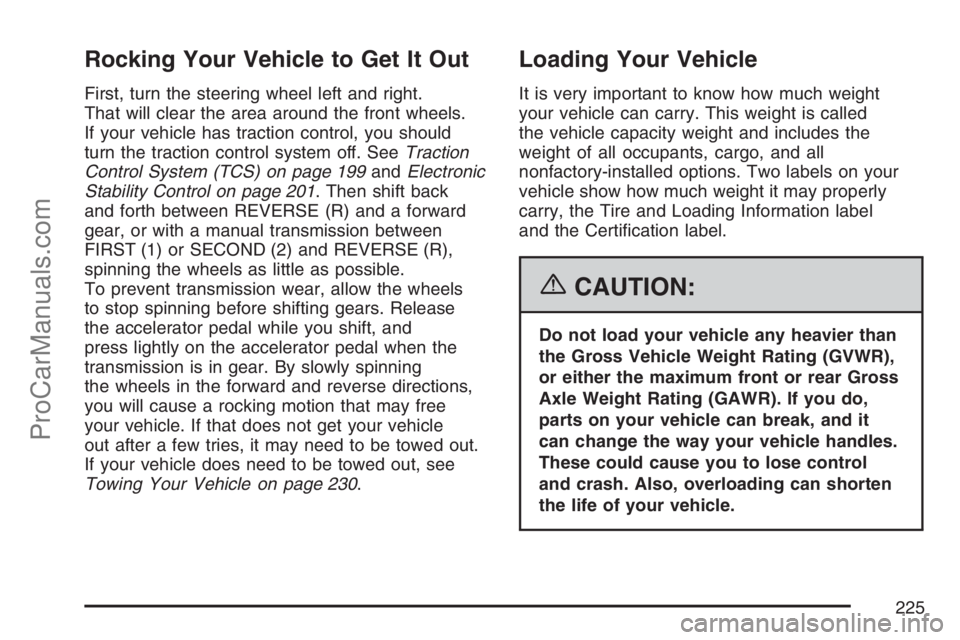
Rocking Your Vehicle to Get It Out
First, turn the steering wheel left and right.
That will clear the area around the front wheels.
If your vehicle has traction control, you should
turn the traction control system off. SeeTraction
Control System (TCS) on page 199andElectronic
Stability Control on page 201. Then shift back
and forth between REVERSE (R) and a forward
gear, or with a manual transmission between
FIRST (1) or SECOND (2) and REVERSE (R),
spinning the wheels as little as possible.
To prevent transmission wear, allow the wheels
to stop spinning before shifting gears. Release
the accelerator pedal while you shift, and
press lightly on the accelerator pedal when the
transmission is in gear. By slowly spinning
the wheels in the forward and reverse directions,
you will cause a rocking motion that may free
your vehicle. If that does not get your vehicle
out after a few tries, it may need to be towed out.
If your vehicle does need to be towed out, see
Towing Your Vehicle on page 230.
Loading Your Vehicle
It is very important to know how much weight
your vehicle can carry. This weight is called
the vehicle capacity weight and includes the
weight of all occupants, cargo, and all
nonfactory-installed options. Two labels on your
vehicle show how much weight it may properly
carry, the Tire and Loading Information label
and the Certi�cation label.
{CAUTION:
Do not load your vehicle any heavier than
the Gross Vehicle Weight Rating (GVWR),
or either the maximum front or rear Gross
Axle Weight Rating (GAWR). If you do,
parts on your vehicle can break, and it
can change the way your vehicle handles.
These could cause you to lose control
and crash. Also, overloading can shorten
the life of your vehicle.
225
ProCarManuals.com
Page 233 of 384
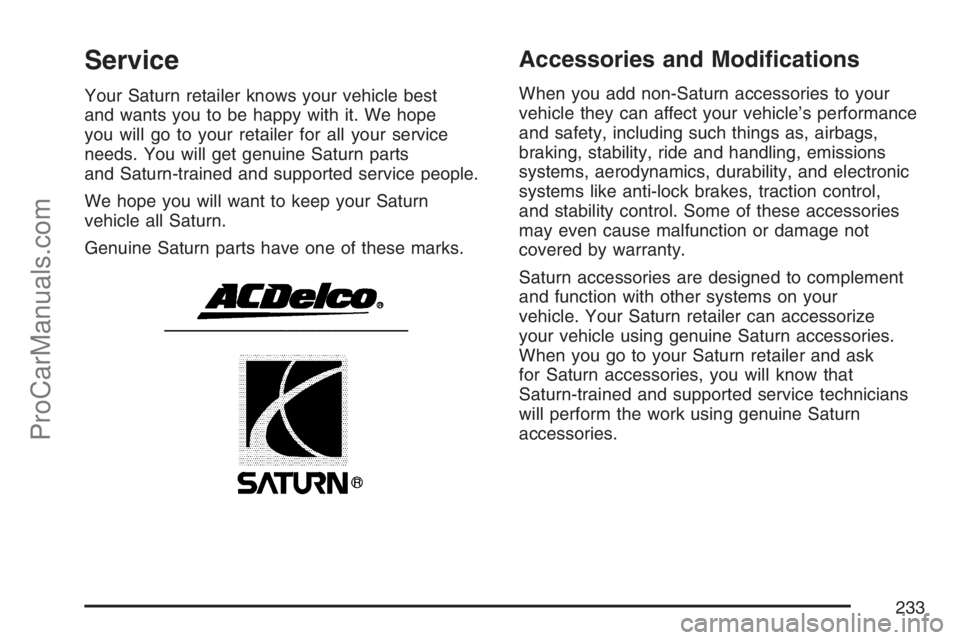
Service
Your Saturn retailer knows your vehicle best
and wants you to be happy with it. We hope
you will go to your retailer for all your service
needs. You will get genuine Saturn parts
and Saturn-trained and supported service people.
We hope you will want to keep your Saturn
vehicle all Saturn.
Genuine Saturn parts have one of these marks.
Accessories and Modi�cations
When you add non-Saturn accessories to your
vehicle they can affect your vehicle’s performance
and safety, including such things as, airbags,
braking, stability, ride and handling, emissions
systems, aerodynamics, durability, and electronic
systems like anti-lock brakes, traction control,
and stability control. Some of these accessories
may even cause malfunction or damage not
covered by warranty.
Saturn accessories are designed to complement
and function with other systems on your
vehicle. Your Saturn retailer can accessorize
your vehicle using genuine Saturn accessories.
When you go to your Saturn retailer and ask
for Saturn accessories, you will know that
Saturn-trained and supported service technicians
will perform the work using genuine Saturn
accessories.
233
ProCarManuals.com
Page 296 of 384
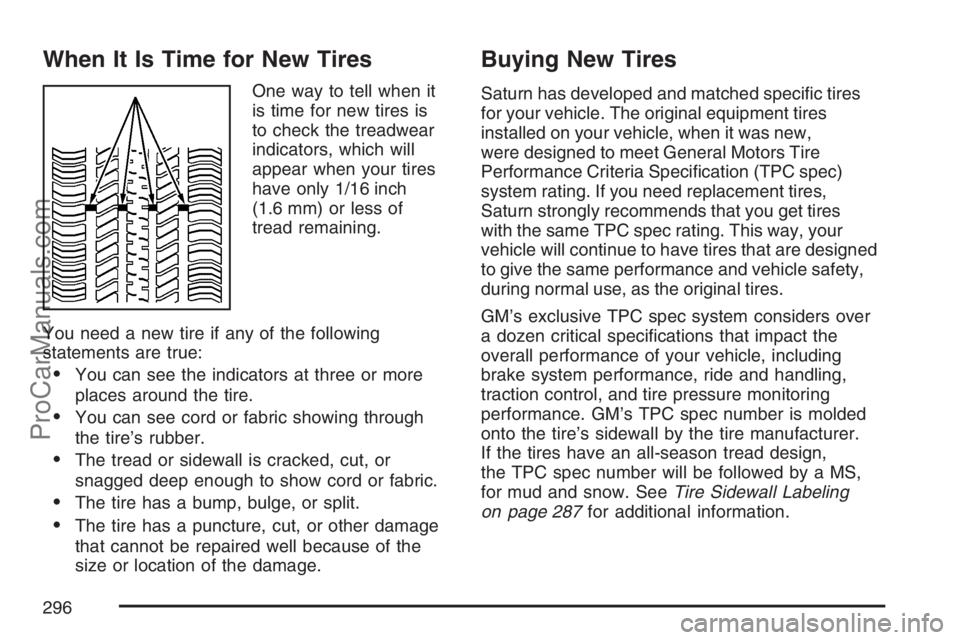
When It Is Time for New Tires
One way to tell when it
is time for new tires is
to check the treadwear
indicators, which will
appear when your tires
have only 1/16 inch
(1.6 mm) or less of
tread remaining.
You need a new tire if any of the following
statements are true:
You can see the indicators at three or more
places around the tire.
You can see cord or fabric showing through
the tire’s rubber.
The tread or sidewall is cracked, cut, or
snagged deep enough to show cord or fabric.
The tire has a bump, bulge, or split.
The tire has a puncture, cut, or other damage
that cannot be repaired well because of the
size or location of the damage.
Buying New Tires
Saturn has developed and matched speci�c tires
for your vehicle. The original equipment tires
installed on your vehicle, when it was new,
were designed to meet General Motors Tire
Performance Criteria Speci�cation (TPC spec)
system rating. If you need replacement tires,
Saturn strongly recommends that you get tires
with the same TPC spec rating. This way, your
vehicle will continue to have tires that are designed
to give the same performance and vehicle safety,
during normal use, as the original tires.
GM’s exclusive TPC spec system considers over
a dozen critical speci�cations that impact the
overall performance of your vehicle, including
brake system performance, ride and handling,
traction control, and tire pressure monitoring
performance. GM’s TPC spec number is molded
onto the tire’s sidewall by the tire manufacturer.
If the tires have an all-season tread design,
the TPC spec number will be followed by a MS,
for mud and snow. SeeTire Sidewall Labeling
on page 287for additional information.
296
ProCarManuals.com
Page 298 of 384
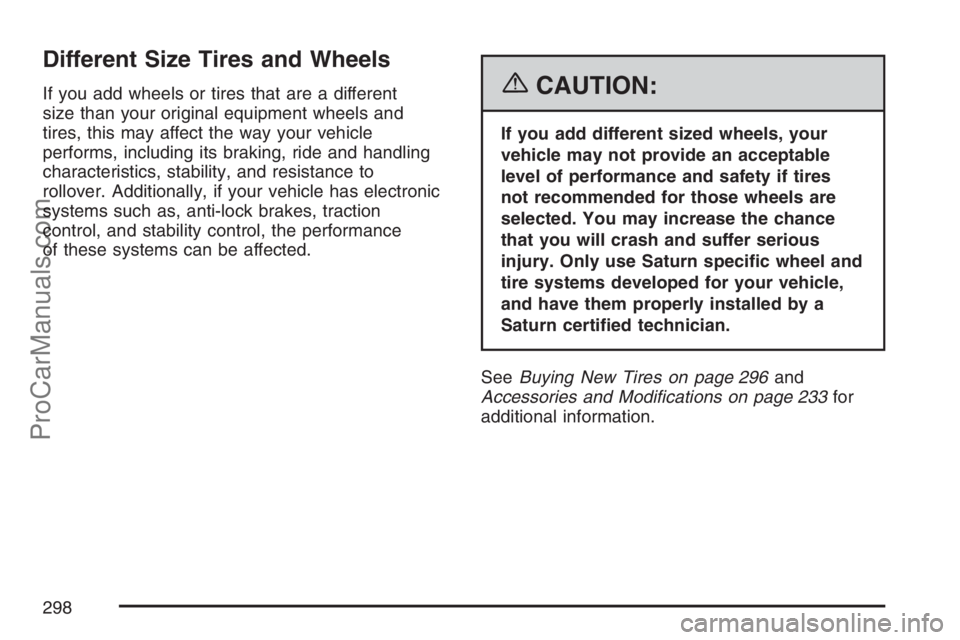
Different Size Tires and Wheels
If you add wheels or tires that are a different
size than your original equipment wheels and
tires, this may affect the way your vehicle
performs, including its braking, ride and handling
characteristics, stability, and resistance to
rollover. Additionally, if your vehicle has electronic
systems such as, anti-lock brakes, traction
control, and stability control, the performance
of these systems can be affected.{CAUTION:
If you add different sized wheels, your
vehicle may not provide an acceptable
level of performance and safety if tires
not recommended for those wheels are
selected. You may increase the chance
that you will crash and suffer serious
injury. Only use Saturn speci�c wheel and
tire systems developed for your vehicle,
and have them properly installed by a
Saturn certi�ed technician.
SeeBuying New Tires on page 296and
Accessories and Modi�cations on page 233for
additional information.
298
ProCarManuals.com
Page 299 of 384

Uniform Tire Quality Grading
Quality grades can be found where applicable
on the tire sidewall between tread shoulder
and maximum section width. For example:
Treadwear 200 Traction AA Temperature A
The following information relates to the system
developed by the United States National Highway
Traffic Safety Administration (NHTSA), which
grades tires by treadwear, traction, and
temperature performance. This applies only to
vehicles sold in the United States. The grades are
molded on the sidewalls of most passenger car
tires. The Uniform Tire Quality Grading (UTQG)
system does not apply to deep tread, winter-type
snow tires, space-saver, or temporary use
spare tires, tires with nominal rim diameters of
10 to 12 inches (25 to 30 cm), or to some
limited-production tires.
While the tires available on General Motors
passenger cars and light trucks may vary with
respect to these grades, they must also conform
to federal safety requirements and additional
General Motors Tire Performance Criteria (TPC)
standards.
Treadwear
The treadwear grade is a comparative rating
based on the wear rate of the tire when tested
under controlled conditions on a speci�ed
government test course. For example, a tire
graded 150 would wear one and a half (1.5) times
as well on the government course as a tire
graded 100. The relative performance of tires
depends upon the actual conditions of their use,
however, and may depart signi�cantly from
the norm due to variations in driving habits, service
practices, and differences in road characteristics
and climate.
Traction – AA, A, B, C
The traction grades, from highest to lowest, are AA,
A, B, and C. Those grades represent the tire’s
ability to stop on wet pavement as measured under
controlled conditions on speci�ed government test
surfaces of asphalt and concrete. A tire marked C
may have poor traction performance.
Warning:The traction grade assigned to this
tire is based on straight-ahead braking traction
tests, and does not include acceleration, cornering,
hydroplaning, or peak traction characteristics.
299
ProCarManuals.com
Page 303 of 384
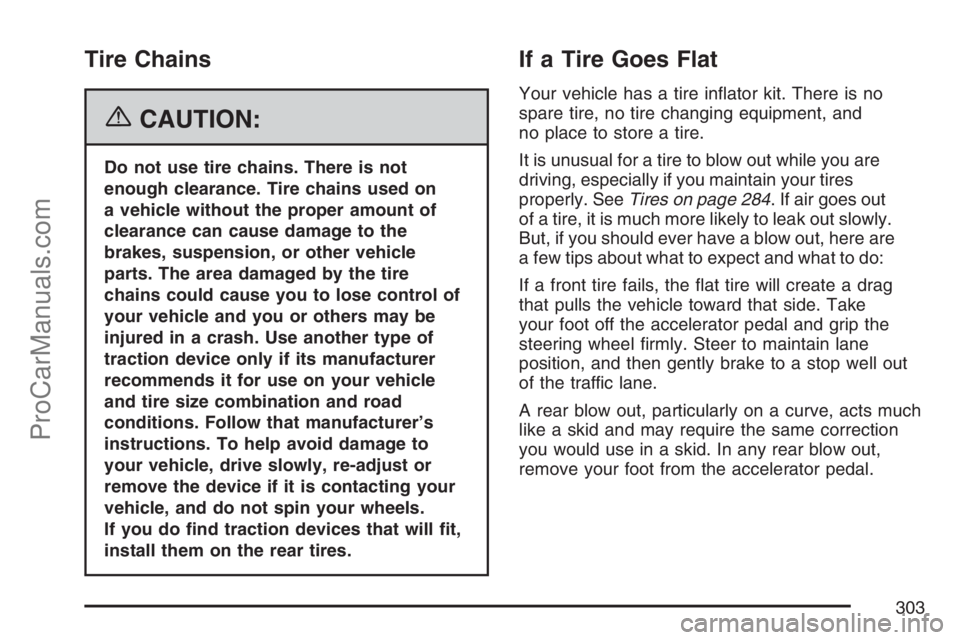
Tire Chains
{CAUTION:
Do not use tire chains. There is not
enough clearance. Tire chains used on
a vehicle without the proper amount of
clearance can cause damage to the
brakes, suspension, or other vehicle
parts. The area damaged by the tire
chains could cause you to lose control of
your vehicle and you or others may be
injured in a crash. Use another type of
traction device only if its manufacturer
recommends it for use on your vehicle
and tire size combination and road
conditions. Follow that manufacturer’s
instructions. To help avoid damage to
your vehicle, drive slowly, re-adjust or
remove the device if it is contacting your
vehicle, and do not spin your wheels.
If you do �nd traction devices that will �t,
install them on the rear tires.
If a Tire Goes Flat
Your vehicle has a tire in�ator kit. There is no
spare tire, no tire changing equipment, and
no place to store a tire.
It is unusual for a tire to blow out while you are
driving, especially if you maintain your tires
properly. SeeTires on page 284. If air goes out
of a tire, it is much more likely to leak out slowly.
But, if you should ever have a blow out, here are
a few tips about what to expect and what to do:
If a front tire fails, the �at tire will create a drag
that pulls the vehicle toward that side. Take
your foot off the accelerator pedal and grip the
steering wheel �rmly. Steer to maintain lane
position, and then gently brake to a stop well out
of the traffic lane.
A rear blow out, particularly on a curve, acts much
like a skid and may require the same correction
you would use in a skid. In any rear blow out,
remove your foot from the accelerator pedal.
303
ProCarManuals.com
Page 378 of 384

Light (cont.)
Highbeam On.......................................... 142
Low Fuel Warning.................................... 143
Malfunction Indicator................................ 138
Oil Pressure............................................. 141
Passenger Airbag Status Indicator............ 131
Passenger Safety Belt Reminder.............. 130
Safety Belt Reminder............................... 129
Security................................................... 142
Traction Control System........................... 136
Trunk Ajar................................................ 142
Lighting
Entry/Exit................................................. 120
Limited-Slip Rear Axle................................. 200
Loading Your Vehicle................................... 225
Locks
Automatic Door Lock................................. 68
Automatic Door Unlock.............................. 68
Delayed Locking........................................ 67
Manual Door.............................................. 66
Power Door............................................... 67
Loss of Control........................................... 208
Low Fuel Warning Light............................... 143M
Maintenance Schedule
Additional Required Services.................... 338
At Each Fuel Fill...................................... 341
At Least Once a Month............................ 341
At Least Once a Year.............................. 342
Introduction.............................................. 334
Maintenance Footnotes............................ 339
Maintenance Record................................ 349
Maintenance Requirements...................... 334
Normal Maintenance Replacement Parts.... 347
Owner Checks and Services.................... 340
Recommended Fluids and Lubricants....... 345
Scheduled Maintenance........................... 336
Using....................................................... 334
Your Vehicle and the Environment............ 334
Malfunction Indicator Light........................... 138
Manual Seats.................................................. 8
Manual Transmission
Fluid........................................................ 254
Operation................................................... 85
378
ProCarManuals.com
Page 383 of 384
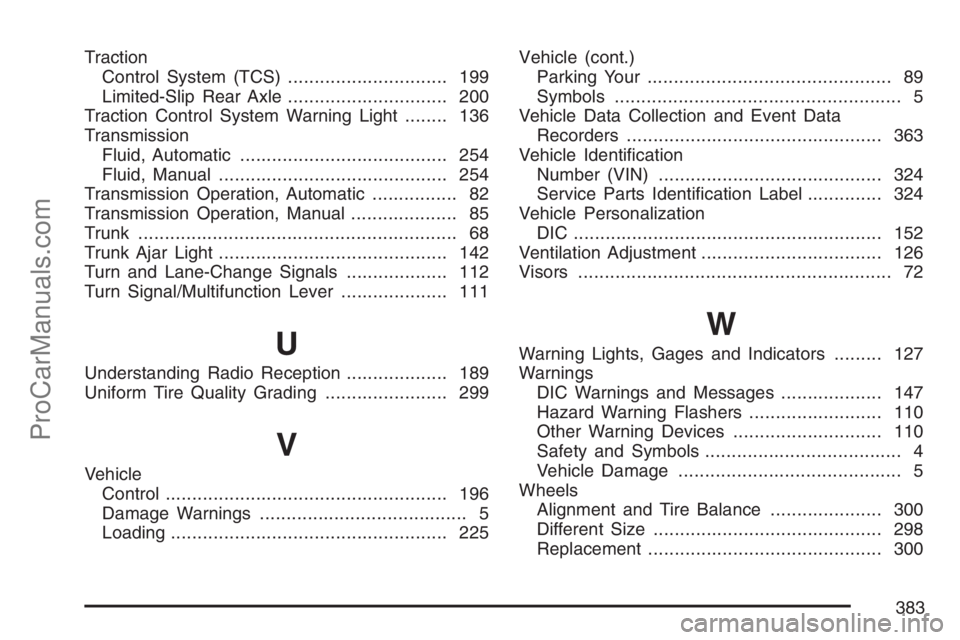
Traction
Control System (TCS).............................. 199
Limited-Slip Rear Axle.............................. 200
Traction Control System Warning Light........ 136
Transmission
Fluid, Automatic....................................... 254
Fluid, Manual........................................... 254
Transmission Operation, Automatic................ 82
Transmission Operation, Manual.................... 85
Trunk............................................................ 68
Trunk Ajar Light........................................... 142
Turn and Lane-Change Signals................... 112
Turn Signal/Multifunction Lever.................... 111
U
Understanding Radio Reception................... 189
Uniform Tire Quality Grading....................... 299
V
Vehicle
Control..................................................... 196
Damage Warnings....................................... 5
Loading.................................................... 225Vehicle (cont.)
Parking Your.............................................. 89
Symbols...................................................... 5
Vehicle Data Collection and Event Data
Recorders................................................ 363
Vehicle Identi�cation
Number (VIN).......................................... 324
Service Parts Identi�cation Label.............. 324
Vehicle Personalization
DIC .......................................................... 152
Ventilation Adjustment.................................. 126
Visors........................................................... 72
W
Warning Lights, Gages and Indicators......... 127
Warnings
DIC Warnings and Messages................... 147
Hazard Warning Flashers......................... 110
Other Warning Devices............................ 110
Safety and Symbols..................................... 4
Vehicle Damage.......................................... 5
Wheels
Alignment and Tire Balance..................... 300
Different Size........................................... 298
Replacement............................................ 300
383
ProCarManuals.com